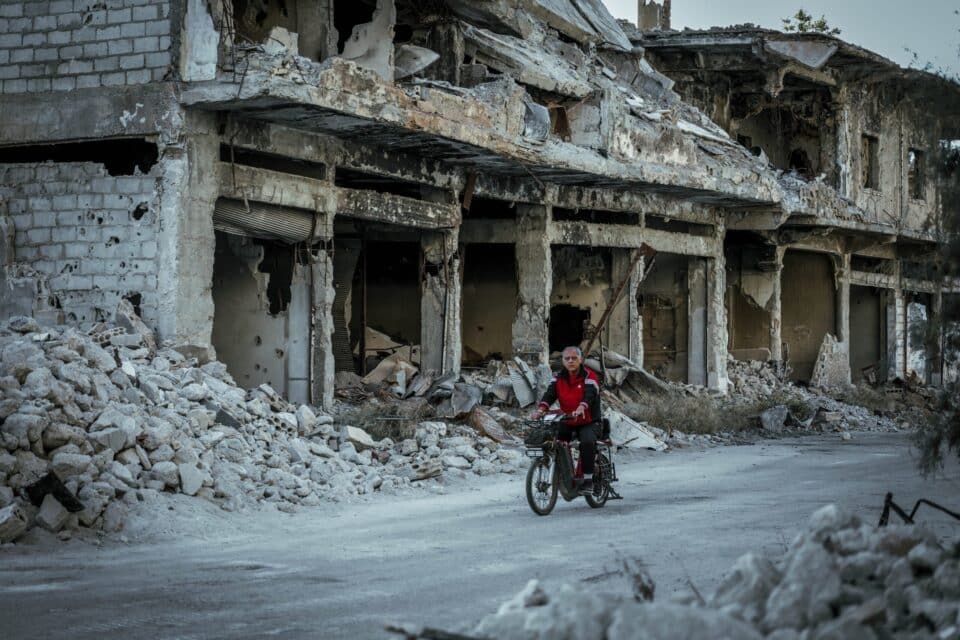Help our local partners realise their vision of hope for their communities

As Europe was coming to terms with the reality of a new war on its soil following Russia’s invasion of Ukraine, Syria was marking a grisly anniversary as the country entered its second decade of civil war.
The conflict – which began as a result of the brutal suppressions of protests against President Bashar al-Assad’s government starting on March 15, 2011 – has since caused up to 610,000 deaths[i], while widescale destruction of civilian and agricultural infrastructure has forced millions of Syrians into chronic poverty and prevented a generation of children from getting regular education.
At the end of 2021, 13.4 million Syrians were in need of humanitarian assistance[ii], and 12.4 million were food insecure[iii]. As of March 2022, there are still 13.3 million forcibly displaced Syrians; 6.6 million are refugees while 6.7 million are internally displaced people (IDPs) within the country[iv].
This means that after eleven years of civil war, Syrians have been forced to flee their homes more than anyone else.
Such prolonged exile from home – regardless of whether it has involved crossing an international border – brings immense challenges, and for many Syrians times are harder now than at any other point during the war.
Syrian IDPs are currently experiencing one of the country’s worst socioeconomic downturns since the crisis began. The Covid-19 pandemic has seen a recent collapse in the value of the Syrian pound, which has led to inflation rates of up to 200% for some of the most basic essentials.
As a result, almost 90% of the population in Syria is now living below the poverty line[v]. This has had especially severe implications for Syria’s children, with 2.5m being forced into work instead of going to school in 2021[vi] as families continued to struggle to make ends meet.
The situation faced by the millions who have been forced to become refugees in neighbouring countries is no easier.
Like Syrian IDPs, refugees’ sources of income have been drying up as a result of the hardships of protracted displacement being exacerbated by the Covid-19 pandemic.
Many have been made unemployed or lost financial support from host families who can no longer afford it, while after such a long period of forced displacement others have depleted the savings they took with them when they fled the country.
This is reflected in some stark statistics: 90% of Syrian refugees in Lebanon currently live in extreme poverty, while even before the pandemic close to 80% of refugees were living on less than $3 a day in Jordan[vii]. Elsewhere, up to 950,000 Syrians in Turkey are in precarious employment in the informal sector[viii], leaving them vulnerable to exploitation and poverty wages.
It is important to remember that these neighbouring countries – who’s economies have been particularly vulnerable during the pandemic – are also where the vast majority of refugees from Syria currently reside. Turkey hosts 3.7 million refugees, while in Lebanon approximately a quarter of the population is a Syrian refugee[ix] (in contrast, the UK resettled 20,000 refugees from Syria between 2015 and 2021[x]).
After eleven years of civil war, the humanitarian needs of Syrian refugees and IDPs are as acute now as at any point during the conflict. While the West rightly continues to support Ukraine, we cannot forget about the tens of millions of Syrians who have been forced to flee their homes.
By Ben Willy, HART Volunteer.
[i] https://www.syriahr.com/en/
[ii]https://reliefweb.int/sites/reliefweb.int/files/resources/syria_2021_humanitarian_needs_overview.pdf
[iii]https://reliefweb.int/sites/reliefweb.int/files/resources/syria_2021_humanitarian_needs_overview.pdf
[iv] https://www.unhcr.org/syria-emergency.html
[v] https://www.unhcr.org/sy/16061-inside-syria-millions-face-destitution-after-a-decade-of-pain.html
[vi] https://www.unhcr.org/sy/16061-inside-syria-millions-face-destitution-after-a-decade-of-pain.html
[vii] https://www.unhcr.org/syria-emergency.html
[viii] https://www.crisisgroup.org/europe-central-asia/western-europemediterranean/turkey/248-turkeys-syrian-refugees-defusing-metropolitan-tensions
[ix] https://www.unrefugees.org/emergencies/syria/
[x] https://www.gov.uk/government/publications/uk-resettlement-schemes-factsheet-march-2021/vulnerable-persons-and-vulnerable-childrens-resettlement-schemes-factsheet-march-2021
Although all blog posts are reviewed by an editorial team, our blog authors all write in a personal capacity and the views expressed are not necessarily those of HART.